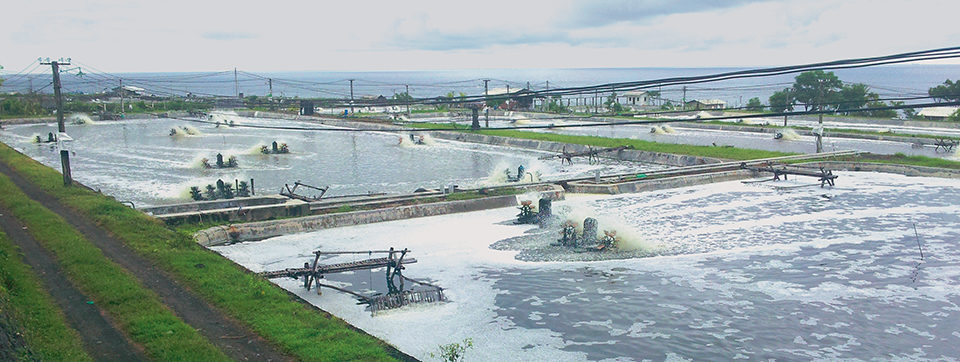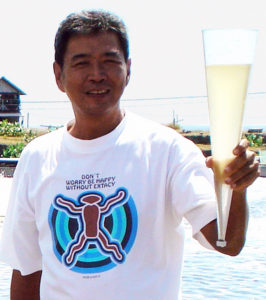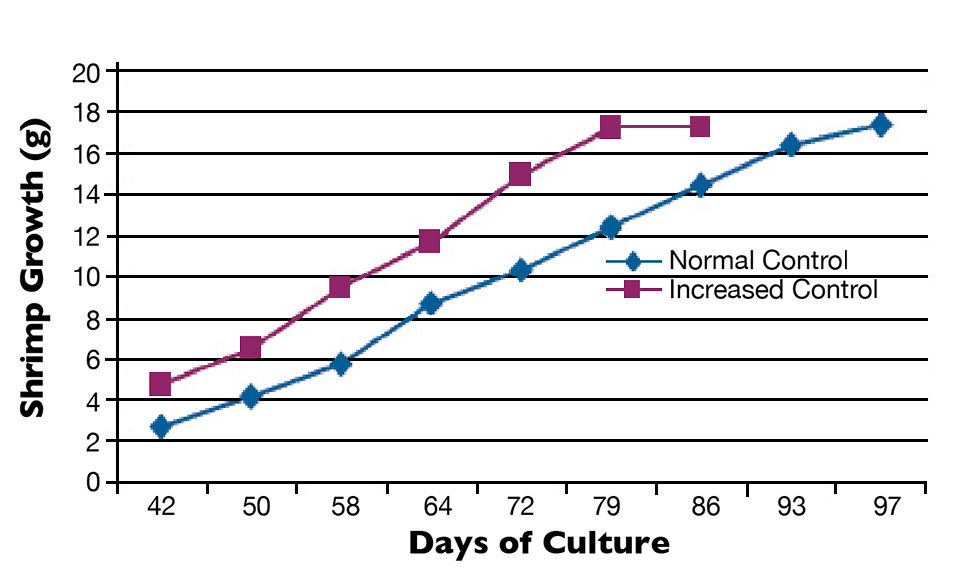Aquaculture on Bali Island exists along tourism-heavy northern coast

Bali Island in Indonesia is a popular tourist destination. However, a few aquaculture facilities, including small shrimp farms, are located here – mostly on the northern coast. Most of the shrimp farms are family owned and operate under intensive production, as the land area is very limited. Ndaru Laut Setio shrimp farm is located at Kubu, on the northern coast of Bali not far from diving resorts. It raises specific pathogen-free Litopenaeus vannamei in ponds.
Farm
Twelve ponds with sizes ranging from 600 to 2,800 square meters operate with two reservoirs that reflect 16 percent of the total culture pond area, just over 2 hectares. All ponds and reservoirs are fully concrete lined and mostly rectangular in shape with an average depth of 1.2 meters. The ponds have central drain systems.
Like a terraced rice field, the shrimp farm is constructed at a slope on the edge of the northern sea coast. Seawater from the open sea is pumped into treatment reservoirs at the highest level. This enables technicians to distribute water to the culture ponds by gravity.
Biofloc technology

The ponds apply basic biofloc technology with zero water exchange. Grain and molasses are added to the culture water to increase the carbon:nitrogen (C:N) ratio, while added aeration supports the biofloc suspended in the water column.
Initially, grain pellets made from wheat flour were used at 10 to 20 percent of the normal feed volume provided, but later only molasses was applied to increase the C:N ratio. On a daily basis, ponds receive about 1 to 2 ppm molasses. The biofloc is maintained below 12 mL/L. A well-known probiotic product was tried during the cycle, but its effects were not clearly seen.
The aeration system helps move excess biofloc and sludge to the centers of ponds or other designated locations to enable removal, when required. In this respect, the positioning of the aerators, which support 400 kg/hp carrying capacity, is very important. A typical carrying capacity with biofloc systems is 600 kg/hp.
Environment
Since ample aeration is supplied, and dissolved oxygen is well controlled, water quality in the culture environment is maintained within normal limits. Biofloc volume is controlled below 10 mL/L, as measured in Imhoff cones. Temperature ranges between 27 and 33 degrees C during the cycle, whereas salinity is kept between 33 and 38 ppt. At times near harvest, however, salinity can exceed 40 ppt.
Dissolved-oxygen levels are kept above 4 ppm, with pH and other parameters within acceptable ranges. At harvest, nitrate can reach 100 ppm, and ammonia and nitrite run high at 8 to 10 ppm.
The farming cycles are scheduled to avoid months with low temperatures, which in Bali are January, February, July and August. January and February reflect a cool, unstable rainy season, whereas in July and August, seawater temperatures below 26 degrees-C can be expected. These conditions are known to contribute to the likelihood of viral outbreaks.
Production
Farm production data from 2012 are provided in Table 1. Initially, only two cycles were achieved in one year, but lately, 2.5 to 3.0 cycles have been targeted.
Taw, Farm production data, Table 1
| Pond | A2 | A3 | F1 | F2 | E1 | E2* | B1 | B2 | B3 | C1 | C2 | C3 |
|---|
Pond | A2 | A3 | F1 | F2 | E1 | E2* | B1 | B2 | B3 | C1 | C2 | C3 |
|---|---|---|---|---|---|---|---|---|---|---|---|---|
| Pond size (m2) | 2,400 | 2,600 | 2,800 | 2,800 | 1,000 | 750 | 2,000 | 2,000 | 2,000 | 600 | 600 | 600 |
| Stocking density (postlarvae/m2) | 170 | 148 | 150 | 145 | 150 | 180 | 155 | 155 | 155 | 175 | 175 | 175 |
| Aeration (hp) | 18 | 18 | 16 | 18 | 6 | 4 | 12 | 12 | 12 | 12 | 6 | 4 |
| Days of culture | 97 | 97 | 97 | 95 | 95 | 45 | 82 | 82 | 81 | 82 | 82 | 81 |
| Body weight (g) | 18.4 | 18.12 | 15.32 | 17.30 | 16.48 | 4.00 | 19.5 | 18.5 | 16.00 | 14.68 | 19.72 | 18.48 |
| Feed-conversion ratio | 1.26 | 1.35 | 1.49 | 1.29 | 1.46 | – | 1.20 | 1.40 | 1.25 | 1.35 | 1.10 | 1.14 |
| Survival (%) | 105.8 | 104.0 | 101.0 | 106.0 | 94.7 | – | 103.9 | 94.0 | 92.9 | 97.4 | 98.5 | 101.9 |
| Production (kg/pond) | 7,914 | 7,281 | 6,388 | 7,682 | 2,345 | – | 6,307 | 5,399 | 4,622 | 1,503 | 2,050 | 1,981 |
| Production (kg/ha) | 32,976 | 28,004 | 22,814 | 27,436 | 23,450 | – | 31,535 | 26,995 | 23,110 | 25,050 | 34,167 | 33,017 |
| Production/power input (kg/hp) | 440 | 405 | 399 | 427 | 391 | – | 526 | 450 | 385 | 376 | 342 | 495 |
Farm total production: 53,472 kg (26,736 kg/ha)
In this cycle, ponds B1, B2, B3, C1, C2 and C3 were under heightened control with a shortened growout period
Table 1. Farm production data, August to November 2012.
Recent farm production from 2 hectares of pond area for one cycle has been 45 to 55 metric tons (MT) or 90 to 110 MT in one year. In the present cycle, added efforts were applied to reduce culture days with intensive feed and controlled biofloc development. This paid off, as shrimp grew faster and the days of culture were reduced to just over 80, compared with the more typical 100 days of culture at the farm (Fig. 1).

Biofloc benefits
The operation started in 2007 as a conventional intensive system with L. vannamei. All 12 ponds were operational at the end of 2008, when shrimp farms in Indonesia were hit hard by infectious mionecrosis virus. The Bali farm was also hit by the virus, but managed to run for 80 to 90 days of culture by using only treated replacement water.
At the time, the biofloc system had been introduced, but the biofloc density control system was not in place. The biofloc volume went up to 15 mL/L, and dissolved-oxygen levels dropped below 2.5 ppm. However, the biofloc technology was fully realized and functional in early 2009. The farm has produced 45 to 55 MT/cycle since 2009 in a stable and sustainable way without viral outbreaks.
(Editor’s Note: This article was originally published in the January/February 2014 print edition of the Global Aquaculture Advocate.)
Authors
-
Nyan Taw, Ph.D.
Consultant
Blue Archipelago Berhad
T3-9, KPMG Tower, 8 First Avenue
Persiaran Bandar Utama 4780
P.J., Selangor, Malaysia -
Surijo Setio
Ndaru Laut Setio
Kubu, Bali, Indonesia
Tagged With
Related Posts

Aquafeeds
Biofloc and clear-water RAS systems: a comparison
This study compared two types of indoor, shrimp culture systems: clear-water RAS and biofloc systems. Clearwater RAS had the edge in water quality, but shrimp in the biofloc treatment had a higher feed conversion ratio.

Aquafeeds
Biofloc consumption by Pacific white shrimp postlarvae
The stable isotopes technique with δ13C and δ15N can be used to determine the relevance of different food sources to shrimp feeding during the pre-nursery phase of Litopenaeus vannamei culture. During this trial, different types of commercial feed, microalgae, Artemia sp. nauplii and bioflocs were used as food sources.

Aquafeeds
Biofloc systems viable for tilapia production
Well-designed and managed biofloc technology systems are a viable alternative for production of various species like tilapia, to increase feed efficiency by lowering aquafeed protein requirements and to help reduce or eliminate effluent discharges.

Health & Welfare
Biofloc technology: Possible prevention for shrimp diseases
Facing emerging viral problems and rising energy costs, the use of biofloc technology in biosecure systems offers an answer for sustainable shrimp aquaculture. The main attributes of biofloc systems in reducing disease risk include the fact that low water exchange improves pathogen exclusion.


